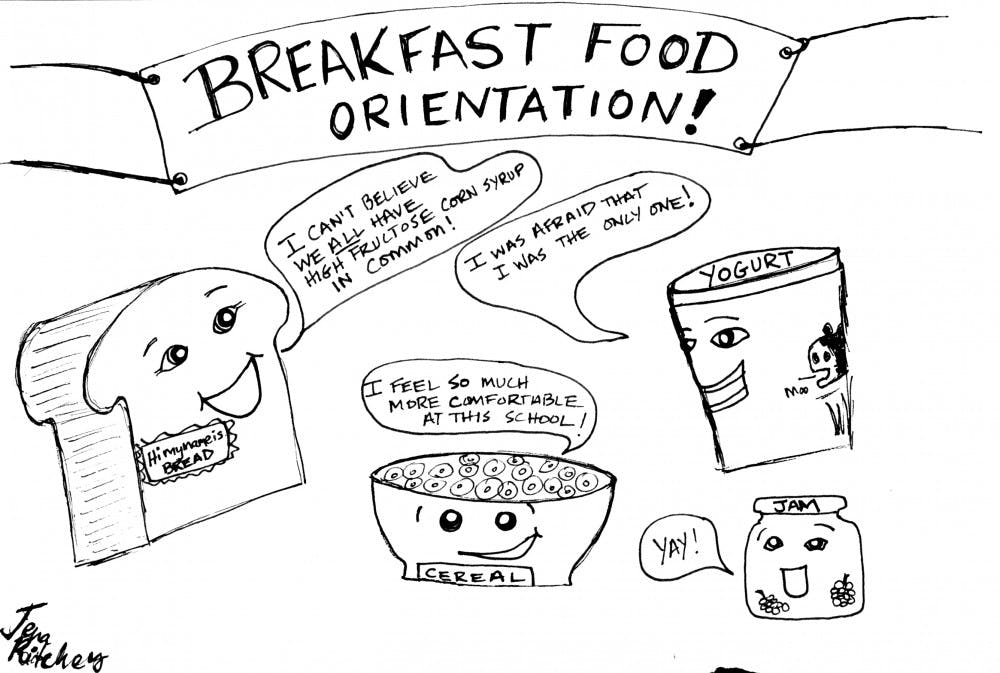We have all seen them: the placards on every table in our dining halls hawking EatReal, a student-run organization seeking to advocate for more socially and environmentally responsible food at the College. The idea is to move toward a food system that is local/community-based, humane, fair and ecologically sound. This is in keeping with the socially and environmentally conscious student body we are fortunate to have here at Middlebury. As someone who cares about the health and wellness of our food system, I applaud the students raising awareness of where the College’s food comes from, how it is grown/raised, etc. However, I do not believe that the EatReal movement captures all that is necessary when it comes to what is important about dining hall food. The sources of our food and the methods used to get it to our plates are certainly very important, but what EatReal has thus far failed to address is what is actually IN the food we eat.
On a number of occasions while at Middlebury, I have walked into the dining halls and looked at the ingredient list for items on the menu, only to be disappointed in what I saw: ingredients such as high fructose corn syrup, cornstarch and corn paste, as well as compounds that utilize seemingly every letter of the alphabet, and require several read-throughs to pronounce. Even items whose ingredient lists are not made available, but which you can tell just by noticing their color, are comprised of unnatural ingredients: things like brightly colored ice cream, nacho cheese, neon desserts, fruit juices (especially that fluorescent Passion Orange Guava juice), sodas and sports drinks. Now, I enjoy sipping an ice cold Gatorade as much as the next guy, but is ingesting the color additives it contains (Blue 1, Red 40 and Yellow 5 are the color additives in the two flavors served in our dining halls, according to Gatorade’s website) really worth it, when their effects on our health are unknown?
Of course, a logical solution to what I have said thus far is to simply not eat anything that contains artificial ingredients: avoid ice cream, desserts, nacho cheese, fruit juices, sports drinks, and the like. But upon closer examination, eliminating everything in the dining halls with artificial dyes/colors and corn-derived additives would leave a scarce selection. While a healthy diet is of the utmost importance, a diet that has variety is important if for no other reason than keeping one’s sanity.
So, why is it even important that we make an effort to eliminate ingredients such as corn-derived additives from the College dining halls? According to Michael Pollan, acclaimed food activist and author of the award winning book, The Omnivore’s Dilemma, artificial sugars such as high fructose corn syrup contribute heavily to type II diabetes, obesity, heart disease and diet-related cancers, all growing problems in America. The average American gets one fifth of their daily caloric intake from high fructose corn syrup. According to the CDC, one in three Americans born after the year 2000 will have type II diabetes. Not only do these additives impose serious health risks, they also quietly contribute substantially to climate change. Ten calories of fossil fuel energy are required for every single calorie of food energy when producing foods whose bases are comprised of corn and soy. Eliminating highly processed, artificial foods from the dining halls will not only benefit the health of the College community, but also will further our cause of combating climate change.
I am not calling for a paradigm shift in how the College selects what foods to present in the dining halls. Rather, I am advocating for a subtle, but significant, change of thought, from “local” to “simple.” Changing our dining hall menus to eliminate artificial dyes/colors, artificial sweeteners, and nutritionally devoid additives like high fructose corn syrup and corn starch need not involve extensive campaigns, placards on tables, or go-slash webpages. On the contrary, all it would take to eliminate these fake foods from the Middlebury diet is a quick check by the folks at Food Services to see if these substances exist in what we currently buy, and if they do, simply buy other products that do not contain them. My hope is that some day, Middlebury students will be able to walk into our dining halls and peruse the ingredient lists for any menu item without seeing “high fructose” this, or “artificial” that, or any additive whose composition only a Chemistry major would understand. And let’s face it: if you can’t pronounce it, you probably don’t want it on your plate.
Artwork by JENA RITCHEY
ETHAN SIVULICH '16 is from New Gloucester, Maine.


